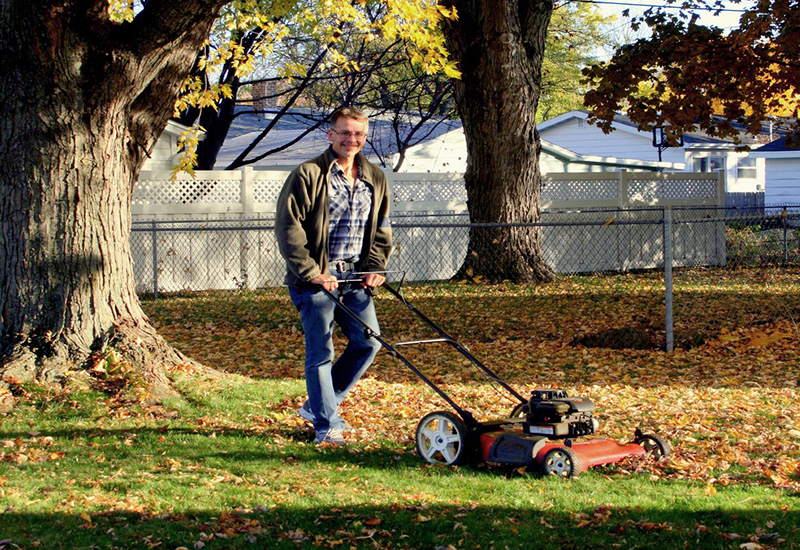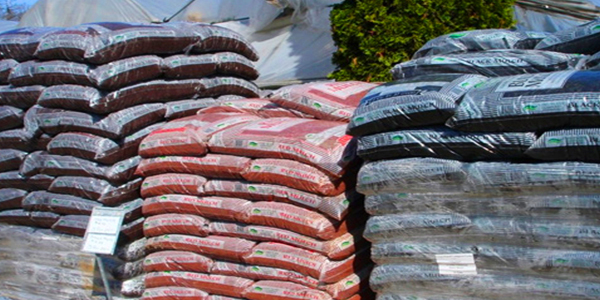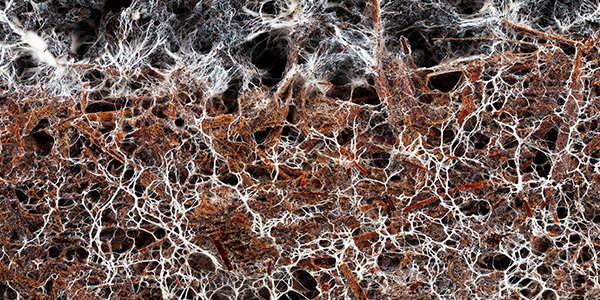Better Leaf Management
Agricultural universities and professional landscaping organizations all agree: effective leaf management contributes to the overall health of the landscape, and is healthier for our planet. This website informs homeowners and professional landscapers of the best leaf management practices, so that everyone can enjoy the benefits of the leaves in the landscape.
A Wasteful and Outdated Practice
The annual ritual of raking, blowing, piling, bagging and removing leaves costs each homeowner – or their landscaper – hours of time each fall. It also robs the yards of one of nature’s greatest resources: rich, natural compost. The practice of leaf blowing causes serious diesel and particulate matter pollution, especially with the 2-stroke backpack leaf blowers so commonly used in suburban backyards.
Luckily there are good alternatives that will save you time AND money! That is why responsible landscapers and homeowners are switching from leaf removal with blowers to the more beneficial approach of leaving the leaves, or of using the leaves as a serviceable product in the yard.
Using the leaves on the property to the advantage of the yard can save municipalities (and taxpayers) tens of thousands of dollars, by avoiding the necessity of municipal collection. It is also a terrific way to support a healthy ecosystem, and to create healthier, quieter, neighborhoods.
Leaf management will differ depending the size of your yard, where you live, and whether you have a lawn or not. Also, a professional landscaper will have other demands than a homeowner. On this site we will try to offer leaf management solutions for all.
Managing Leaves on the Lawn
Leaves on the lawn can smother and damage the grass. But rather than blowing them off the lawn, we advocate mulch-mowing the leaves. Mulching involves chopping the leaves into small pieces with a lawn mower. Mulching the leaves on the lawn has many advantages: It reduces noise and greenhouse gases. It enhances the health of the lawn. The shredded/mulched leaves fall between the grass blades and and decompose, enriching the topsoil. The benefits of mulching the leaves into the lawn are numerous and most are scientifically substantiated:
- Mulching is quieter and cleaner than leaf blowing
- Mulching reduces the need for fertilizer and avoids water pollution by reducing phosphorus and fertilizer leaching
- Mulching reduces the safety hazard of piled up or bagged leaves on the roadsides and saves taxpayer money for municipal leaf collection
- Mulching improves soil structure, improving water retention, drainage and percolation
- Mulching encourages the grass roots to penetrate more deeply, improving grass health
- Mulching makes the lawn more resilient to weather events like drought and flooding.
Learn more about mulch-mowing on these pages: Mulch-Mowing > and For Professionals >
Electrification of the Landscaping Industry
Electric and battery-operated leaf blowers are much cleaner and quieter than gas-powered tools. The efficiency of battery-operated landscaping equipment has improved enormously in recent years and all major landscape equipment manufacturers offer electric options. Electric tools are safer to operate and require less maintenance than gas-operated engines. While batteries have their own environmental concerns, they compare very favorably to combustion engines. To encourage the electrification of the landscaping industry, some municipalities, counties and states have started to offer incentives, like partial refunds, for electric equipment.
The Many Ways Leaves Can Be Used in the Landscape
Support Biodiversity
Leaf litter offers important habitat for amphibians, pollinators, birds and other wildlife.
Fertilize Naturally
With the use of leaf mulch and leaf compost we can avoid the use of synthetic fertilizers.
Make America Rake Again
Smaller lawns can be managed with a rake. Raking is healthy for you, and moving the leaves from the lawn with a rake is the best way to preserve wildlife, like butterflies and fireflies, that are hiding in the leaves. Many homeowners are reducing the size of their lawns by planting shrubs, perennial beds, or by installing a meadow. A smaller lawn saves time and energy and allows for more natural, environment-friendly, growth in the remaining part of the yard. For more information about sustainable gardening visit: www.healthyyards.org
Leave Leaves Alone is located in Bedford Hills, NY email: leaveleavesalone@gmail.com











